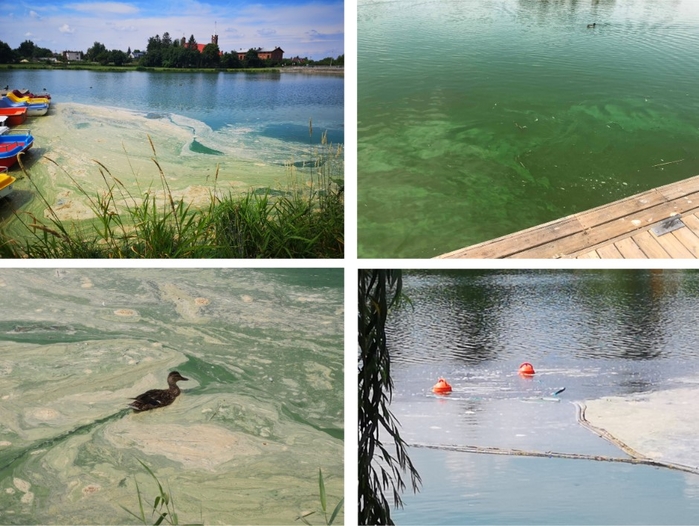
The development of phytoplankton (microscopic "plant" organisms) is a result of, among others, economic activity of man. It leads to over-enrichment of water bodies with nutrients and, as a result, to the expansion of cyanobacteria, also in temperate climate zones, which in turn is influenced by global warming. Among the groups of bloom-forming microorganisms, the greatest attention is paid to the cyanobacteria due to their ability to produce toxic compounds – cyanotoxins, as products of their secondary metabolism. Cyanotoxins, in turn, are dangerous to humans.
Why do cyanobacteria "bloom" in Stryków?
The artificial reservoir in Stryków was created in 1991 for water sports and recreational purposes. It is located along the 38th kilometer of the Moszczenica river in the Lodz Metropolitan Area. This attractive landscape area is subject to strong human pressure: many houses have been built in the area and the communication with the water supply infrastructure has been developed. In addition, large logistics centres have been constructed near the junction of the A1 and A2 motorways. Apart from a few isolated forest areas, which are under reserve protection, the surroundings of the reservoir are dominated by agricultural fields and orchards with wastelands.
The scientists analysed the causes of the unusual persistent bloom of cyanobacteria in the Stryków artificial reservoir. They conducted comprehensive studies of the ecosystem, including a study of climate change, hydrochemical analysis and assessment of the ecological state of the river and reservoir, along with monitoring of the content of cyanobacteria in phytoplankton. They selected three sampling sites: two at the Moszczenica river channel (one in front of and one behind the reservoir) and one at the reservoir.
The presence of cyanobacterial toxins in the water was reported in the second half of June and the first half of July, when environmental conditions are most conducive to the development of cyanobacteria. The release of toxins begins with the death of the first cyanobacterial cells. Their presence in the water ruled out the recreational use of the reservoir in Stryków for about half a year.
The research concerned the factors that affect the multiplication of individual plant microorganisms. It has shown, among others, that the persistent presence of Microcystis (freshwater cyanobacteria forming harmful blooms) in the biomass was associated with the N/P ratio, which is influenced by the presence of artificial fertilisers washed from the fields in the water. On the other hand, the presence of Aphanizomenon and Dolichospermum (cyanobacteria that inhabit freshwater lakes and can cause dense blooms known for their nitrogen biding abilities) resulted from the overlapping effect of two environmental factors – high temperature and high values of electric conductivity of water. This phenomenon is getting intensified with global climate change.
Man and the river, i.e. the "hosts" of dangerous cyanobacteria
The findings also indicate a significant role of the Moszczenica river in the multiplication and mass bloom of cyanobacteria. It carries water rich in nutrients from areas developed by man, feeds the Stryków artificial reservoir with it and "fertilises" it, causing uncontrolled development of phytoplankton. Like in other similar cases, this is the result of improper ecosystem management - reservoirs whose catchment is subjected to long-term human impact (agricultural use fertisilsation associated with it, inflow of pre-treated municipal sewage, etc.) will always be exposed to toxic blooms of cyanobacteria. Global warming only exacerbates the process.
The sum of these factors causes water bodies to “bloom” and be excluded from use. For example, in reservoirs that are a source of drinking water, toxic cyanobacteria blooms completely exclude its use. The development of cyanobacteria is also manifested by the formation of "unsightly" blue-green biomass floating on the surface, a change in the colour of water and its unpleasant smell. Recreational use of reservoirs during algal blooms carries the risk of contact with cyanobacterial cells that secrete toxins, swallowing the water in which they are present, or simply inhaling them with drops of water suspended in the air. Direct contact with cyanotoxins can even lead to death! Therefore, the appearance of cyanobacteria results in an immediate ban on bathing in water bodies, and this, in turn, affects the restriction of tourist traffic.
***
The research team studying cyanobacteria in the Stryków artificial reservoir included: prof. Joanna Żelazna-Wieczorek (Faculty of Biology and Environmental Protection, University of Lodz), dr Paulina Nowicka-Krawczyk (Faculty of Biology and Environmental Protection, University of Lodz), mgr Izabela Skrobek (Faculty of Biology and Environmental Protection, University of Lodz), prof. Maciej Ziułkiewicz (Faculty of Geographical Sciences, University of Lodz), dr Michał Adamski (Institute of Botany, Polish Academy of Sciences), dr Ariel Kaminski (Jagiellonian University) and dr Paweł Żmudzki (Jagiellonian University).
You can read more about the team's research and the analysis of climate and hydrochemical data in an article published by its members in the "International Journal of Environment Research and Public Health".
Source: prof. Joanna Żelazna-Wieczorek, Faculty of Biology and Environmental Protection of the University of Lodz
Edit: Promotion Centre of the University of Lodz
